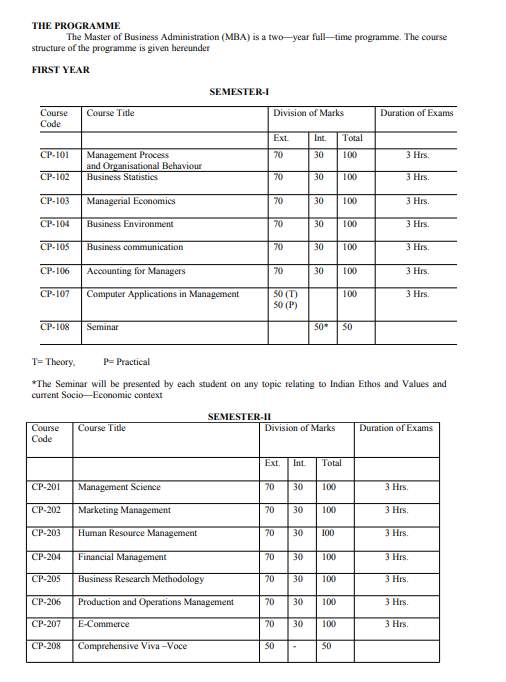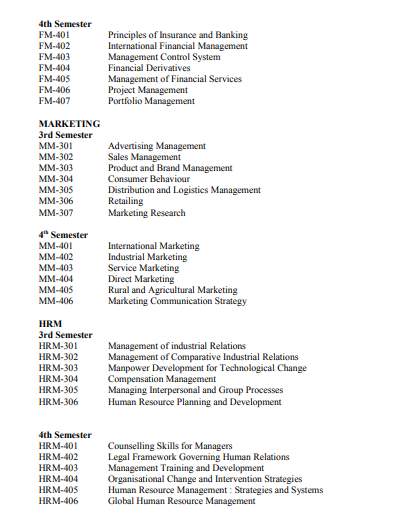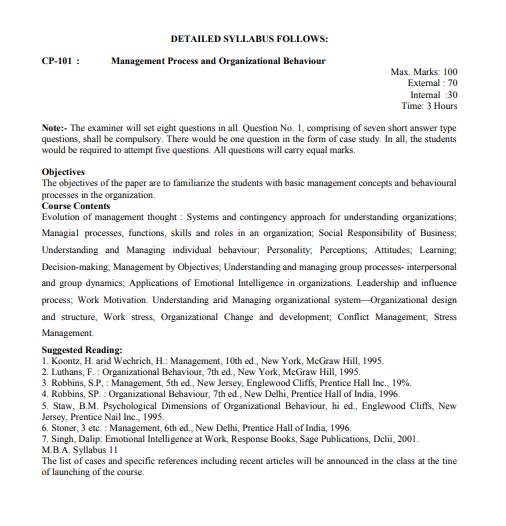| Re: MBA Syllabus Kurukshetra University
Kurukshetra University was established in the year 1957. It is located at Kurukshetra, India . It is affiliated to UGC .
It offers two year duration MBA course .
Semester-I
Management Process and Organisational Behaviour
Business Statistics
Managerial Economics
Business Environment
Business communication
Accounting for Managers
Computer Applications in Management
Seminar
Semester-II
Management Science
Marketing Management
Human Resource Management
Financial Management
Business Research Methodology
Production and Operations Management
E-Commerce
Comprehensive Viva –Voce
Semester-III
Business Policy and Strategic Management
Business Legislation
Summer Training Report
Semester-IV
Entrepreneurship Development
Research Project
Comprehensive Viva Voce voce on research project) (including viva-Voice )
Kurukshetra University MBA course syllabus
DETAILED SYLLABUS FOLLOWS:
Note:- The examiner will set eight questions in all. Question No. 1, comprising of seven short answer type
questions, shall be compulsory. There would be one question in the form of case study. In all, the students
would be required to attempt five questions. All questions will carry equal marks.
Objectives
The objectives of the paper are to familiarize the students with basic management concepts and behavioural
processes in the organization.
Course Contents
Evolution of management thought : Systems and contingency approach for understanding organizations;
Managia1 processes, functions, skills and roles in an organization; Social Responsibility of Business;
Understanding and Managing individual behaviour; Personality; Perceptions; Attitudes; Learning;
Decision-making; Management by Objectives; Understanding and managing group processes- interpersonal
and group dynamics; Applications of Emotional Intelligence in organizations. Leadership and influence
process; Work Motivation. Understanding arid Managing organizational system—Organizational design
and structure, Work stress, Organizational Change and development; Conflict Management; Stress
Management.
Suggested Reading:
1. Koontz, H. arid Wechrich, H.: Management, 10th ed., New York, McGraw Hill, 1995.
2. Luthans, F. : Organizational Behaviour, 7th ed., New York, McGraw Hill, 1995.
3. Robbins, S.P, : Management, 5th ed., New Jersey, Englewood Cliffs, Prentice Hall Inc., 19%.
4. Robbins, SP. : Organizational Behaviour, 7th ed., New Delhi, Prentice Hall of India, 1996.
5. Staw, B.M. Psychological Dimensions of Organizational Behaviour, hi ed., Englewood Cliffs, New
Jersey, Prentice Nail Inc., 1995.
6. Stoner, 3 etc. : Management, 6th ed., New Delhi, Prentice Hall of India, 1996.
7. Singh, Dalip: Emotional Intelligence at Work, Response Books, Sage Publications, Dclii, 2001.
M.B.A. Syllabus 11
The list of cases and specific references including recent articles will be announced in the class at the tine
of launching of the course.
Note :—The examiner will s eight questions in all. Question No.1, comprising of seven short answer type
questions, shall be compulsory. In all, the students would be required to attempt five questions. All
Questions will carry equal marks.
Objective
The objectives of this course is to make the students learn about the application of statistical tools and
techniques for decision- making.
Course Contents
Univariate Analysis : An overview of central tendency, dispersion, aid skewness.
probability Theory; Classical, relative and subjective probability,
- Addition and multiplication probability models; Conditional probability and Baye’s Theorem.
Probability Distributions: Binomial, Poisson, and normal distributions; Their characteristics and
applications. Sampling and sampling methods; Sampling and non-s Sampling erros’s; Law of Large
Number and Central Limit Theorem; Sampling distributions and their characteristics.
Statistical Estimation and Testing; Point and interval estimation of population mean, proportion, and
variance; Statistical testing of hypothesis and errors; Large and small sampling tests—Z, t and F tests.
Non—Parametric Tests: Chi-square tests; Sign tests; Wilcoxon Signed— Rank tests; Kruskal—Wallis test.
Correlation and Regression Analysis : Two variables case.
Index Numbers : Meaning and types; Weighted aggregative indices-Laspeyre’s and Paasch’s indices;
Laspeyre’s and Paasth’s indices compared, indices of weighted average of (price and quantity) relatives;
Tests of adequacy Special problems—shifting the base; splicing, overlapping index series; Uses and
problems of Index number; Time Series Analysis; Trend Analysis.
Statistical Quality Control : Causes of variations in quality characteristics, Quality control charts, - purpose
and. logic; Constructing a control chart computing the control limits (X and R charts); Process under
control and out of control, Warning limits; Control charts for attributes -fraction defectives and number of
defects Acceptance sampling.
Suggested Readings:
1. Hooda, R.P. : Statistics for Business and Economics, Macmillan, New Delhi.
2. Heinz; Kohler : Statistics for Business & Economics,. Harper Collins; New York.
3. Heinz, LW : Quantitative Approach to Managerial Decisions, Prentice Hall, NJ.
4. Lawrence, B. Morse: Statistics for Business & Economics, Harper Collins, NY.
5. Levin, Richard I and David S Rubin : Statistics for Management Prentice Hail, Delhi.
6. Watsnam Terry J. and Keith Parramor: Quantitative Methods in Finance international, Thompson
Business Press, London.
The list of cases and specific references including recent articles will be announced in the class at the time
of launching of the course.
Max. Marks 100
External: 70
Internal: 30
Time: 3 Hours
Note:- The examiner will set eight questions in all Question No.1, comprising of seven short answer two
questions, shall be compulsory. In all, the students would be required to attempt five questions. All
Questions will carry equal marks.
Objectives
The objectives of this course is to acquaint the students with concepts and techniques used in Micro—
Economic Theory and to enable them to apply this knowledge in business decision- making. Emphasis is
given to changes in the nature of business firms in the context of globalization.
Course Contents
Nature and scope of Managerial Economics. Importance of Managerial decision—making; Marginal
analysis; Objective of a finn, Demand function, Elasticity of demand and its significance in Managerial
decision-making; Consumer equilibrium-utility and indifference curve approach; Price, income and
substitution effects; Fundamentals of demand estimation and forecasting; Short-run and long-run
production functions; Cost curves and economics of scale; Price and output determination under perfect
competition, monopoly, monopolistic, competition, and oligopoly; Pricing strategies and tactics; National
Income— alternative concepts aid measurement of National income; Inflation—types, measurement and
control; Balance of Payments; Monetary and Fiscal Policies.
Suggested Readings:
1. Peterson, Lewis, Managerial Economics, Prentice Hall of India, N. Delhi.
2. Salvatore, Managerial Economics in Global Economy; Thomson learning; Bombay.
3. EF. Brigham And J,L. Pappas, Managerial Economics, Dryden Press, illinois.
4. Dwivedi, D.N. Managerial Economics, Vikas Publishing House, New Delhi.
5. Mebta, P.L. Managerial Economics, Sultan Chand, New Delhi.
The list of cases and specific references including recent articles will be announced in the class at the time
of launching of the course.
Note: — The examiner will set eight questions in all, Question No.1, comprising of seven short answer
types questions, shall be compulsory. In all, the students would be required to attempt five questions. All
Questions will carry equal marks.
Objectives
The primary objectives of this course are to acquaint the students emerging global trends in business
environment.
Course Contents
Nature, components and determinants of business environment, dynamics of business environment, key
indicators; Risk in business environment, Assessing business environment — country risk and political
risk.
Current stale of business environment in lndia Economic reforms — Liberalisation, privatisation,
globalisation, industrial policy and industrialisation trends, public enterprise reforms and disinvestment
programmes; competitive environment; financial environment
Indi’s current balance of payment position, globalisation trends, Trade reforms & trends, FIJI poky &
trends, India’s share iii world economy.
Trends in global trade & investment; Nature & operations of multilateral economic institutions- World
Bank, WTO IMP and their impact on Indian business environment. Factors of global competitiveness.
Suggested Reading:
1. Daniel, John D and Radebangh, Lee H : Internatinal Business, 5th ed., New York, Addison Weley, 1989.
2. Charles W. Hill, International Business, fourth edition, Tata MCGraW Hill Publications Companies
3. AK. Sundaram J. Stemart Block : The International Business Environment PHI
The list of cases and specific references including recent articles will be announced in the class at the time
of lunching of the course.
Note :- The examiner will set eight questions in all. Question No.1, comprising of seven short answer type
Question shall be compulsory. In all, the students w1d be required to attempt five question All Questions
will carry equal marks.
Objectives
The course is aimed at equipping the students with the necessary techniques and skills of commUfli0hl to
inform others inspire them and enlist their activity and willing cooperation in the performance of their jobs.
Course Contents
Importance and nature of business communication, Effective communication skills; Process of
communication Oral and Non-Verbal communication, Barriers and gateways in communication and Do’s
and Don’t of business writing, Commercial letters; Writing business and academic reports; Presentation of
reports; Public speaking, listening and Negotiations; conducting and attending interview and meetings.
Suggested Readings:
1. Petett & Lesikar: Business Communication.
2. Petett & Lesikar: Essential of Business Communication.
3. Bowman, Joel and Branchaw, Bernadine P. : “Business Communication: From Process to Product”,
1987, Dryden Press, Chicago.
4. Hatch, Richard : “Communication in Business”, 1977, Science Research Associates, Chicago.
5. Murphy, Herta A and Peck, Charrles E. : “Effective Business Communications”, 2nd ed., 1976, Tata
McGraw Hill, New Delhi.
6. Pearce, C Glenn etc. : “Business Communications Principles and Applications”, 2nd ed., 1988, John
Wiley, New York.
7. Treece, Maira, “Successful Business Communications”, 3rd ed., 1987, Allyn and Bacon, Boston.
The list of cases and specific references including recent articles will be announced in the class at the time
of launching of the course.
Contact Details :
Kurukshetra University
Kurukshetra, Haryana 136119
01744 238 169
For detailed syllabus , here is the attachment;
|



